#docomomo kosovo
Text
Discovering Kosovo
I was virtually traveling to Kosovo, to meet Bekim Ramku, architect, urban designer, curator and critic based in Prishtina. He runs Kosovo Architecture Foundation (KAF) and Prishtina Architecture Week (PAW). Bekim served as a Research Fellow at MIT’s Department of Urban & Spatial Planning in Cambridge, USA.

He is also the founding chair of the DoCoMoMo National Chapter in Kosovo and founding member of the Future Architecture Platform. Previously, he served as the Curatorial Advisor to Martino Stierli, the Philip Johnson Head Curator of Architecture and Design at the Museum of Modern Art in New York, and as the Commissioner to the Kosovo Pavilion at the Venice Biennale Architecture Exhibition in 2012 and 2014.
---

Docomomo Kosovo Workshop in 2017 | Photo © KAF
In 2020 you transfer Kosovo architecture festival online where you created four and a half weeks of program online?
Bekim Ramku: In totally we had 36 presentations with two workshops. Lectures are easier to organise online as there is no need for any special logistics. What you miss is the physical interaction, which we have during the festival in Prishtina. It is of course more difficult for the organisers but it gives a sort of charm that you can’t get via the online festival.
What are the analysis of the festival dissemination from this years edition comparing with the other years?
BR: We have three time more visits than usual number. In our festival we run 40 to 50 activities, meaning lectures, debates, workshops, exhibitions, and we get 5000 followers. This time we got more that 15.000 visitors, which means we received the global reach.

Alejandro Aravena’s lecture on KAF 2015 | Photo © KAF
You are also working at Docomomo Kosovo on the protection of modernism in Kosovo; what was the acceptance of the architecture from Yugoslavia in Kosovo after the MoMA exhibition?
BR: It is difficult as people are still mentally connected with Serbia on the topics of Yugoslavia. Bringing on the topic to protect the Yugoslav architecture is alway controversial here. When I was giving interview before the MoMA exhibition the journalists would ask me to speak about the library and Kosovo architecture and were not so much interested in Yugoslav architecture. You have a lot of people that think it’s kind of provocative topic but also people who understand that Yugoslav is an important architectural period to be protected. Unfortunately people that think that this architecture should be demolished are in majority, particularly in the government. It happened that the appearance of the modernist architecture changed because of such people, like Kosovo Parliament redone in the 1960s by Juraj Neidhardt, the Rilindja Print House by Georgi Konstantinovski, Civil Engineering School in Prishtina and a lot of other buildings in Kosovo. Recently Arber Sadiki, who was part of MoMA exhibition, published a book on Prishtina modernism.

Conservation and management plan for the National Library of Kosovo | Photo © KAF
If I am not wrong you succeed to list the National Library in Prishtina on the list of protected heritage of Getty Foundation?
BR: In 2016 we were fortunate enough to do a project on the National Library with the Getty Foundation Keep it Modern Grant. We did the conservation management plan and a Dossier to enlist the building on the permanent list. It it still on the temporary list because we have this strange body called Kosovo Council for Cultural Heritage, which is dysfunctional several years but it decide who gets on the permanent list. We were told by the administers that we deliver the most complete Dossier they ever saw and it will probably be the first building in Kosovo on the permanent list.
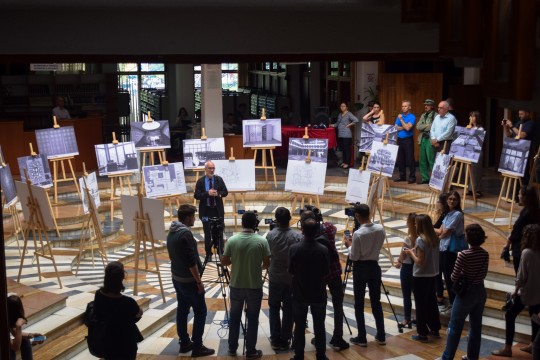
Antoine Wilmering opening the Getty exhibition KAF 2018 | Photo © KAF
What about the presentation of the monument of the National Liberation Struggle in Yugoslavia?
BR: The one from Bogdanović in Mitrovica is still ok, there was a beautiful monument in Pec made from bronze, which has just disappeared. They made an awful abstract park. In Prishtina there was a sculpture of Boro and Ramiz and the Boro’s head was taken off. There is a joke saying can you return it because that’s head is Ramiz’, the other guy is Boro, you mixed them up. In Kosovo polje is also a beautiful monument, which is still not demolished. It is really difficult to protect them, we send a long list of monuments and buildings, we would like to enlist on the temporary list, but there is not enough information or value to protect them. It also depend on who is in the ministry of culture, then monuments for partisans will probably not be on this list.
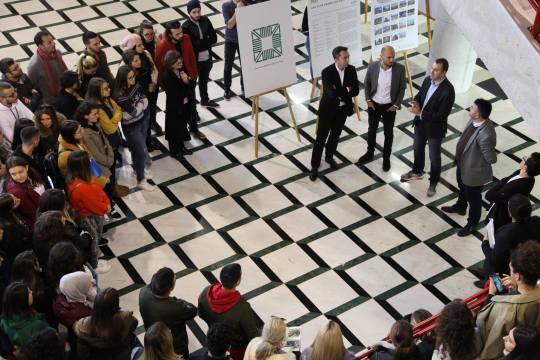
Opening the Aga Khan Award for Architecture 2016 exhibition at Epoka University, Tirana | Photo © KAF
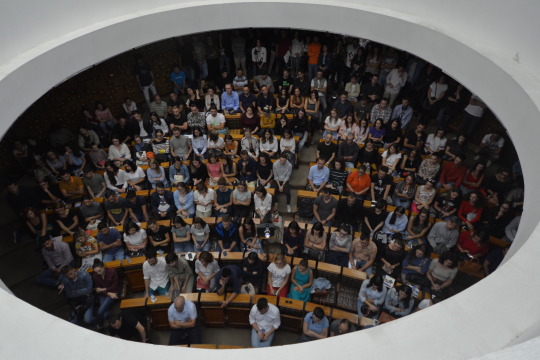
David Basulto lecture on KAF 2018 | Photo © KAF
You mentioned that is quite difficult to present anything with the predisposition of Yugoslavia in Prishtina; would maybe help to transfer the idea of solidarity and unity in the sense of today’s Europe in the context of new togetherness?
BR: It is difficult to get support from public institutions because they would always comment “fine, good for you, but find the money somewhere else”. Even when we produced the modernistic map of Prishtina there were problems with the modernistic ones as the authors were mostly Serbian. We were therefore turned down and not funded as we shall present more Albanian architectures. The modernist map of Prishtina was so funded by the French Embassy.

Ivan Kucina lecture at KAF 2018 | Photo © KAF
You are also a Founding Member of the Future Architecture platform, what did it bring to KAF?
BR: Future Architecture brought a lot to KAF! We were in a difficult position when we joined. It helped KAF financially and we brought interesting people to Kosovo. People that apply to FA are pioneers in the architecture field. We for example invited people from Bartlett that are doing video games urbanism, we did a workshop with Architecture for refugees in Roma neighbourhood and many others. We presented all these people to local students with tools and methodologies that are not introduced in schools, so it is a kind of alternative education for them.

Babau Bureau Workshop Vila Rotonda KAF 2018 | Photo © KAF
Was is your personal experience on global scale, with MoMA in New York?
BR: It was interesting as an initiative as I meet Martino Stierli just few months before he was named a new head curator at MoMA as his partner is from Kosovo and they came to visit Kosovo. We did architecture tours and Martino said he would love to do an exhibition about Yugoslavia. Few months later I got an email from him as an official invitation for working on the exhibition asking help to introduce him to the people from the region, to Vladimir Kulić, Matevž Čelik, Maroje Mrduljaš and others. Of course MoMA is a powerful organisation and institution, they gathered original drawings, models and plans. At the end there was this conflict of interest regarding the original material, should it be kept in MoMA or return back. On Matevž initiative we did the letter where we asked for the material to be returned back to the host institutions. I could say that Balkans network is much more collaborative than the global one. For us is always important to invite people form the region and show that Kosovo in different as they imagine it.

The National Library Pristhina at the MoMA exhibition in New York, 2018 | Photo © KAF
0 notes
Text
Dignity Of Memory
After almost 30 years since the break-up of Yugoslavia, we can take a stroll through a part of the architectural history with the benefit of distance.
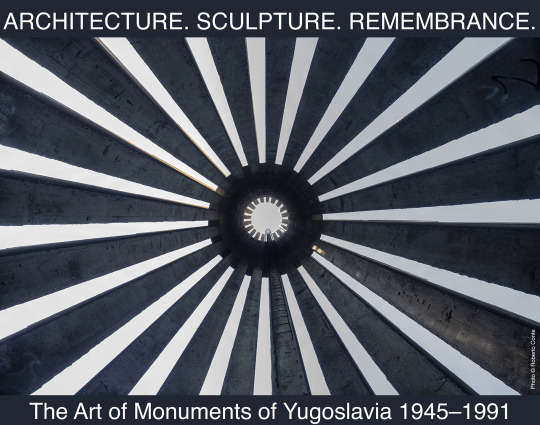
The heritage of Yugoslav architecture was taken on almost a decade ago by Croatian Architects Association in collaboration with Maribor Art Gallery with the regionally conceived project Unfinished Modernisations – Between Utopia and Pragmatism – Architecture and Urban Planning in the Former Yugoslavia and the Successor States, and last year with the global exhibition in New York City's MoMA Toward a Concrete Utopia: Architecture in Yugoslavia, 1948–1980.
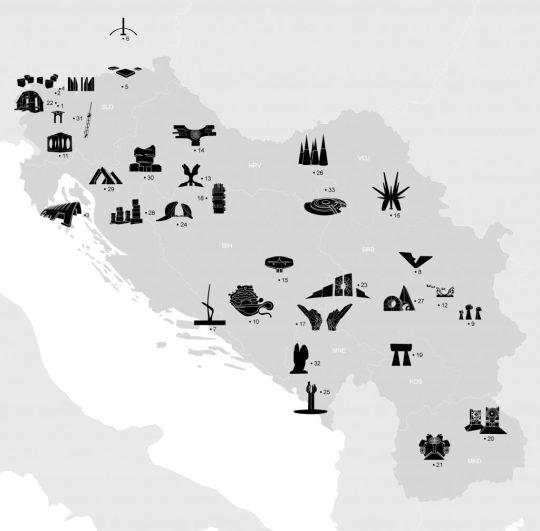
In the architecture and art of ex-Yugoslavia, the monuments to the victims of the People's Liberation War stand out. Through their artistic language, they remind us of the dignity of human life and death. They are powerful markers of the once-common state's public open space. Their unique architectural and artistic design has placed them on a field of timelessness, which is not constrained by geographic and cultural borders, age, race, or political views.

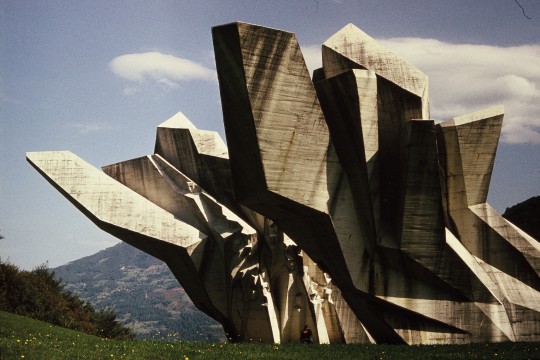
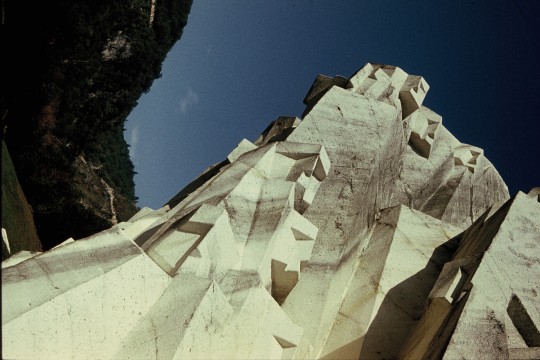
Memorial complex to the Battle of Sutjeska is an exceptional work by Miodrag Živković and one of the best sculptural memorials in the Yugoslav space. | Photo from the archive of Miodrag Živković
Monuments were built and designed by Yugoslav architects and sculptors of the highest profile, such as Bogdan Bogdanović, Edvard Ravnikar, Miodrag Živković, Dušan Džamonja and many others. Instead of the regime's symbolism, their creations combined the present, the past, the elements of antique necropolises, ethnography and spatial poetics.
youtube
Last and First Men by Johann Johannsson (2020) narrated by Tilda Swinton
The monuments are predominantly designed as sculptural-architectural structures, abstract architectural sculptures. Many were constructed in concrete, which was elevated to the status of noble material by virtue of shaping and finishing. They are sited in authentic spatial situations and historical settings, designed as a commemorative path. Every monument tells a story connected with the events and victims.
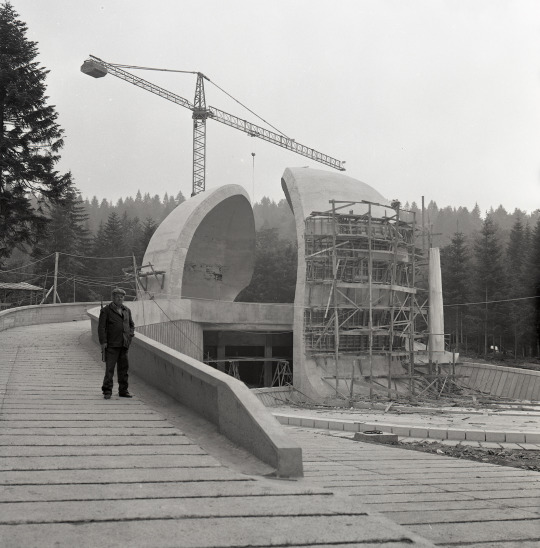
Memorial complex Korčanica is dedicated to the largest Partisan hospital, which was active in the liberated territory of the slopes of Grmeč between 1942 and 1943. | Photo from the archive of Miodrag Živković
In mid-march 2019, Gallery DESSA, ab-Architect's Bulletin magazine and Architectuul began the preparations for the exhibition and publication named Architecture. Sculpture. Remembrance.; The Art of Monuments of Yugoslavia 1945–1991. On the basis of high architectural and artistic value of the structures and the exceptional contemplative qualities of the spatial designs, the curators selected 33 monuments and memorial complexes from all the republics and autonomous provinces of ex-Yugoslavia. The exhibition was prepared in collaboration with authors, photographers, institutions from the ex-Yugoslav region, which has also laid the foundation for future co-operation. The exhibition will present and evaluate the exceptional architecture of the Yugoslav monuments, whose aesthetic and structural innovation is enhanced by their idiosyncratic artistic expression.
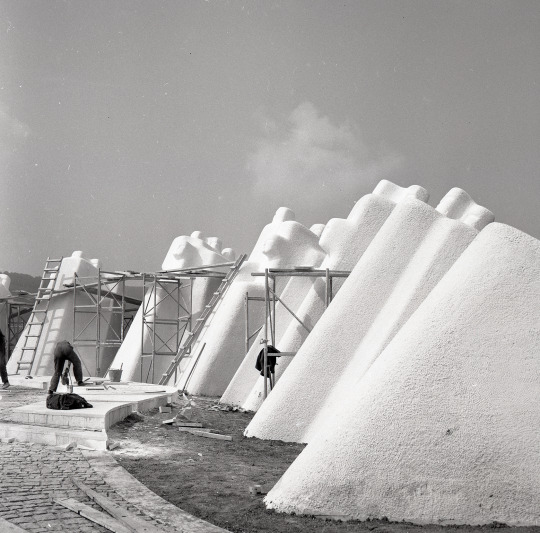
The memorial complex Kadinjača by is dedicated to the Partisan fighters of Workers' Battalion of Užice. | Photo from the archive of Miodrag Živković

Monument to the Revolution by Dušan Džamonja is located at the highest peaks of Kozara mountain. | Photo from the archive of Miodrag Živković
Monuments are also political art, they are an uncompromising tribute to humanity, to reverence towards the victims, conveyed by means of the authors' individual artistic expression. With the dissolution of Yugoslavia into individual independent states in 1991, it seems that the need for respecting the remembrance expressed by its memorials is waning. As a result, the present state of repair of the monuments and their treatment varies depending on the region. In some places, the past and the strivings of the previous generations are held in respectful memory while elsewhere, the monuments have been abandoned, left to ruin, or even desecrated.
youtube
“Beck’s Legendary - Croatia Infiltration” is a beer commercial, which exploits the Monument of Petrova Gora.
Due to their abstract nature, they may be used for very different purposes, such as shooting TV advertisements and music videos, or as fashion runways. Such use of monuments by individuals who have no appreciation or knowledge of the past and therefore cannot respect it represents misuse as well as contempt for the dignity of the victims and their memory.
youtube
The exhibition is planned to be shown in all the former Yugoslav republics. We wish to foster a sober and respectful assessment of the value of ex-Yugoslav monuments and draw attention to their cultural and contemplative significance, and thus lend support to the maintenance and preservation of the memorial areas. It will present the exceptional, progressive, and still-contemporary creative language of their artists and other creators, which transcends the superficiality of the quest for the different, the exotic, the picturesque, and the unknown. Monuments are ties to the past, they reminiscent of the dignity of human life and death. And remembrance.
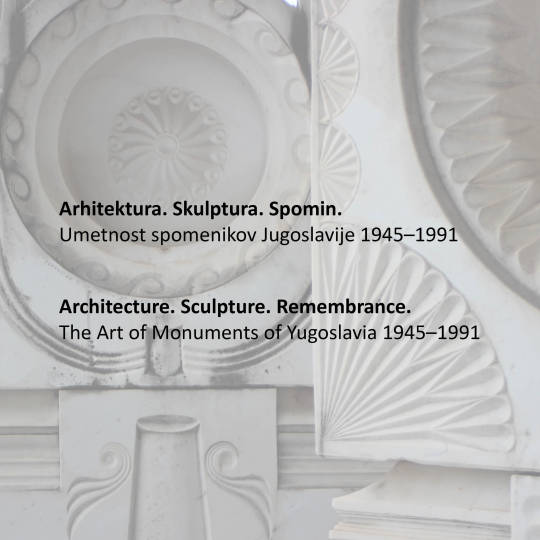
The exhibition started to travel to different cities of the territory of Ex-Yugoslavia. Because of COVID-19 restrictions the project continues online. The next stop is co-hosted by the creative community Avtomatik Delovišče under the auspices of the Municipality of Koper. Together with Architectuul 33 monuments will be presented daily with a conclusion online webinar on 29. November 2020.
---
Architecture. Sculpture. Memory.
The art of monuments of Yugoslavia 1945–1991
online webinar 29 November 2020
Dessa, AB, Avtomatik Delovišče
Curators Boštjan Bugarič, Kristina Dešman, Maja Ivanič, Špela Kuhar, Eva Mavsar, Špela Nardoni Kovač, Damjana Zaviršek Hudnik
Media partner Architectuul
***********
Program
10:00 Introduction
Christian Burkhard, editor in Chief Architectuul, Berlin
Boštjan Bugarič, senior editor Architectuul, Berlin
Mara Ivanič, Dessa Gallery, Ljubljana
youtube
10:20 Spaces and Dignity
Sanja Horvatinčić, Institute of Art History, Croatia
Vladimir Deskov, School of architecture and design - UACS, N. Macedonia
Ana Ivanovska, Faculty of Architecture Skopje, North Macedonia
Kristina Dešman, Maja Ivanič, Špela Kuhar, Eva Mavsar, Špela Nardoni Kovač, Damjana Zaviršek Hudnik, DESSA Gallery, Slovenia
Jelica Jovanović, Grupa arhitekata / Docomomo Serbia
Boris Trapara, Bosnia and Herzegovina
Bekim Ramku, Docomomo Kosovo
Slavica Vučković, Faculty of Architecture Podgorica, Montenegro
Moderator: Boštjan Bugarič
11:00 Yugoslavia Express
Roberto Conte presenting the field photo trip
11:30 Presentation and Dignity
Roberto Conte, Italy
Relja Ivanić, Serbia
Matija Kralj, Croatia
Elena Chemerska, North Macedonia
Donald Niebyl, Spomenik Database USA
Andrew Lawler, Spomenici NOB, Serbia
Moderator: Kristina Dešman
12:00 Embodied Experiences: Investigating the relation between architecture, landscape and symbolism in WW2 monuments of socialist Yugoslavia; a master thesis by Vida Rucli, Faculty of Architecture in Ljubljana, menthors Maruša Zorec and Luka Skansi
12:30 Culture Routes in Montenegro
Slavica Vučković presenting the project
13:00 (In)appropriate Monuments: Interview with Miodrag Živković
In loving memory of Miodrag Živković by Jelica Jovanović
youtube
61 notes
·
View notes
Text
In Vino Veritas Biennale Style!
It was the Vernissage days at the 2014 Biennale, and for me those of the Vernissage are the most exciting days to visit the exhibition, more for the fact that you get to meet with old friends than for the presented works as because of the large number of people you can never experience it as you should. During the Vernissage one usually spends the morning and afternoon visiting the pavilions openings, meeting up with friends and of course having a lot of Aperol spritz. And evenings are usually reserved for the parties.
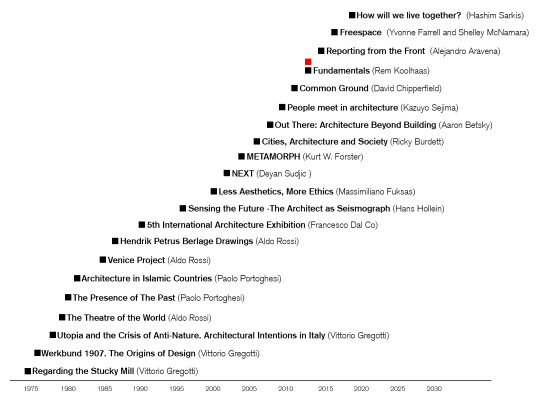
Read also “Teatro del Mondo: An Odyssey”
That was the second time that I was involved with the Kosovo National Pavilion as Commissioner on behalf of the Ministry of Culture after our first participation as Kosovo at the Biennale in 2012.
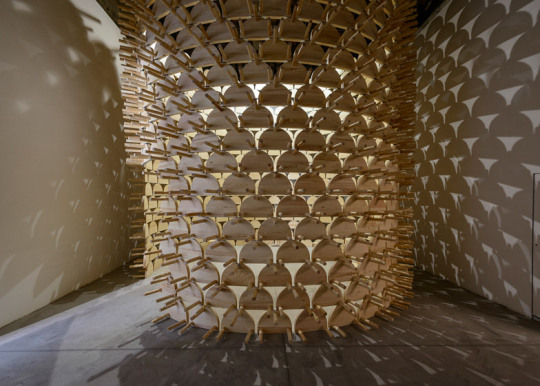
Kosovo National Pavilion in 2014 | Photo © Andrea Avezzu'
On the second night of the Vernissage I was supposed to go to the Turkish party, which was organized by Murat (Tabanlioglu) at one of the Venetian islands, but during the day I met up with two close friends Winy (Maas) and Jan (Knikker) from MVRDV who invited me to a somewhat private dinner at a restaurant nearby San Marco Square. “You have to come and you'll going to love it, but it’s a strictly personal invitation”, Jan told me.
It was a bit difficult to reach the place as my phone battery was very low and I was trying to find it without using Google Maps. I finally did find it and, although I thought I was late, apparently most of the guests also got lost and everyone was showing up at around the same time.
So I entered this room that was not larger than 4x4 meters, with a large table in the middle and people sitting around it, and a second row of chairs behind them. I set at one of the chairs close to Jan and could identify some of the people sitting at the large table. Apparently Winy was the moderator of this “debate” and the other people attending were Aaron Betsky, Patrik Schumacher, François Roche & Peter Noever. Anyhow, before the debate started, a gentleman, that I later learned was Robert White, welcomed everyone to the second night of the "Dark Side Club" talks and asked for drinks to be served.
After drinks were poured and Winy made his short opening speech, which was supposed to set the tone of the debate, each participant around the table had his own turn to talk about the curators’ work. I'm not sure if it was the drinks, the late hours or the intimacy of the place, or maybe all of them, but all of the participants around the table took their terms at criticizing Rem (Koolhaas). Everything went on smoothly, with all participants jabbing Rem and telling architecture jokes, but the mood suddenly changed after Patrik (Schumacher) declared that the curated work was brilliant and that the future of architecture was parametric!
This was the moment the "architecture roast" started and the gloves were off! Roche, Noever, and Betsky were all yelling at Patrik. I must say that after few minutes I felt bad for Patrik being called a narcissist, childish, a preacher, etc., and at one point was thinking of standing up and screaming he “knows that parametricism is just a tool" but I think he was enjoying the fact that the debate focused on him and also Betsky anticipated me by telling Patrik that he doesn’t like using offensive words but he felt the need to say to him to "F..k off". After that he stood up and left the table!
Patrik defense of his view and others’ criticism continued until the end of the debate which apparently lasted for another 2 hours although to me it seemed much shorter than that.
I must say that this was the most fun I had in a Biennale-related event and I was told that these kinds of matchups of participants take place on purpose so the debates are always super interesting. This provided me with the incentive to do something similar back home at the Kosovo Architecture Festival, which involved those Future Architecture young creatives we invited to the event.
Probably because of the young age of our participants “Debates over Beers" were not that serious and they ended up with the young fellows imitating "starchitects" and raising philosophical questions on the meaning of life and why one should become an architect, with the latter definitely being the result of drinking too much beer!
I'm really sorry that just minutes into the Venice “Dark Side Club” debate my cell phone died and couldn’t take any photo to show. All I can add is that I did ask everybody in the room to lend me their power bank to recharge my phone but no one was willing to do it!
There is a link at uncube magazine blog on the DSC I participated at.
***
VAB 01: Bekim Ramku

Bekim Ramku is an architect, urban designer,curatorand criticbased in Kosovo. Apart from running Kosovo Architecture Foundation (KAF) and Prishtina Architecture Week (PAW) Bekim heads an Office of Urban Design+Architecture a multidisciplinary practice based in Prishtina. He received his Architecture Engineering Diploma from Prishtina University and his Masters in Housing and Urbanism from the AA School of Architecture in London. He also served as a Research Fellow at MIT’s Department of Urban & Spatial Planning in Cambridge, USA. Bekim is the founding chair of the DoCoMoMo National Chapter in Kosovo and founding member of the Future Architecture Platform.
He serves as a consultant and expert for European and Global agencies and initiatives, as an independent expert for the Mies Van der Rohe Awards, as an international expert for Bloomberg’s “Global Designing Cities Initiative”, and as an Architecture and Planning Consultant for the World Bank GSURR. Previously, he served as the Curatorial Advisor to Martino Stierli, the Philip Johnson Head Curator of Architecture and Design at the Museum of Modern Art in New York, and as the Commissioner to the Kosovo Pavilion at the Venice Biennale Architecture Exhibition in 2012 and 2014. Past three years he also served as an advisor to the Kosovo Minister of Culture.
1 note
·
View note
Text
Architecture In Danger
Based on Docomomo International alerts regarding threatened Modern Movement heritage, we will present a new campaign: Architecture in Danger - which aims to prevent demolition and to promote the dissemination of Forgotten Masterpieces within our community.
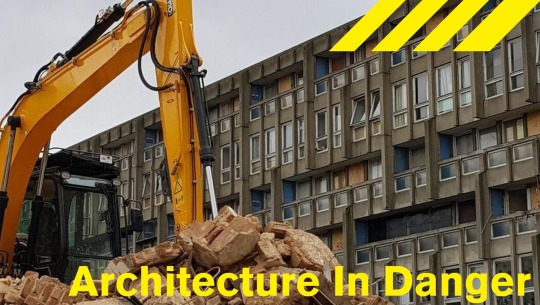
The first demolition case is the Robin Hood Gardens, the post-war brutalist housing estate in east London by Alison and Peter Smithson. Despite years of campaigning from architects and heritage bodies is now underway demolition.
youtube
Video captures Robin Hood Gardens ahead of demolition. | Video via Dezeen
The Twentieth Century Society revived its earlier campaign to have the building saved in 2014. Its report claimed that the decision not to protect the estate with a formal heritage listing the first time around was ill-judged. Post-war architecture and Smithons expert Dirk van den Heuvel describes the estate as a rare, majestic gesture, both radical and generation in its aspiration for an architecture of human association. Also Richard Rogers, Zaha Hadid, Robert Venturi and Toyo Ito joined the protests against the destruction of the complex.
Ultimately the campaign failed for a second time and the developer Swan Housing Association with the backing of Tower Hamlets council revealed its plans for a new housing estate named Blackwall Reach.
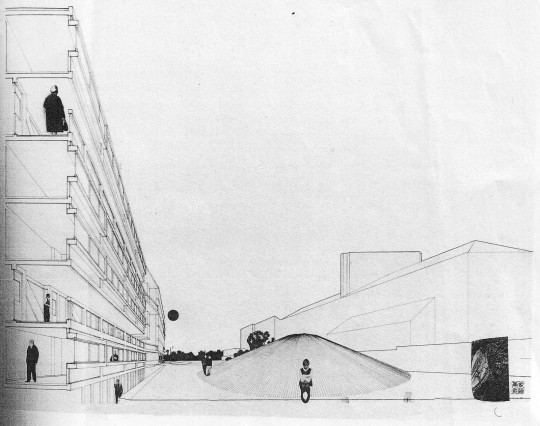
Original drawing for the Robin Hood Gardens. | © Alison and Peter Smithson
The National Theatre of Albania dates in 1939 following the Italian occupation of Albania. Previously a movie theatre was primarily built to serve Italian soldiers as a form of entertainment (dopolavoro).
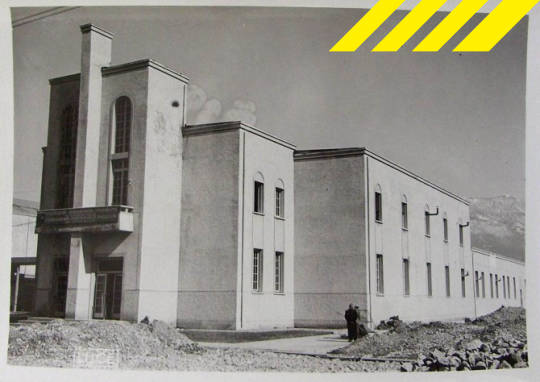

The building of the National Theatre of Albania at the beginning of the construction in the 1940s and today. | Photo via Balcanicaucaso
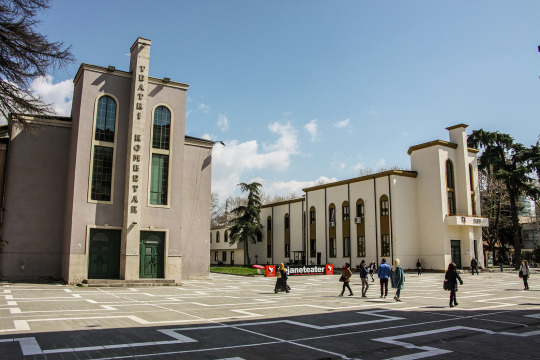
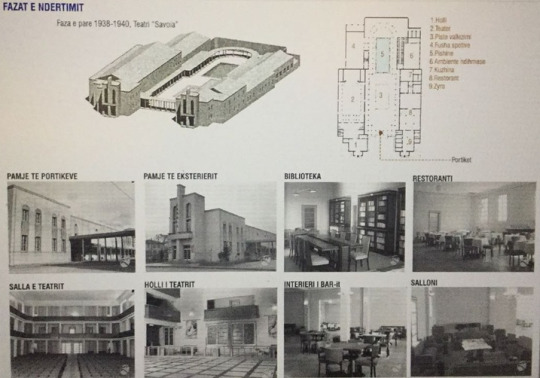
This rationalist building was one of the first constructed Italian architectural works in Albania. | Photo by T. Mali and via Voice of Albanians
Today the Albanian authorities have announced the demolition and the construction of a new complex, where BIG plan to build three indoor performance spaces, a rooftop amphitheater and a covered public space beneath the grounds of the current theater. Therefore people started to protests against government plans to demolish the iconic building. Facing these circumstances, Docomomo International would like to express encouragement to the on-going efforts to protect the building from demolition.
The Technical Faculty of Pristina University is one of Prishtina modern landmarks. The building that was designed by one of the most important Slovenian architects of its time, Edvard Ravnikar. It is of great importance for the city as well as the Modern Movement in the region. To the primary flat roof was added current tile roof. As one of the few buildings representing that movement and period in the City of Prishtina, should be fully preserved for what strives Docomomo Kosovo.
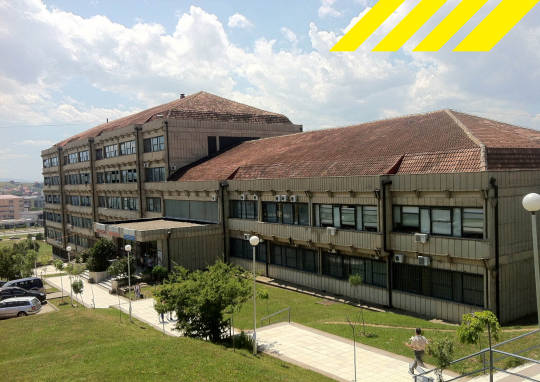
One of the best representatives of the late Modern Movement in the region of South-Eastern Europe. | Photo © Bostjan Bugarič
The National Theatre in Uganda is the main component of the Uganda National Cultural Centre. Designed by Peatfield and Bodgener Architects, it was the first modern and purpose built theatre in Uganda.

In keeping with the principles of tropical modernism, the building is naturally ventilated. | Photo © Jim and Hilda Dixon
Docomomo International expressed its full support for the preservation of the National Theatre and is glad to announce that it has been successfully refurbished and reopened in September 2018 as part of Uganda National Cultural Centre.
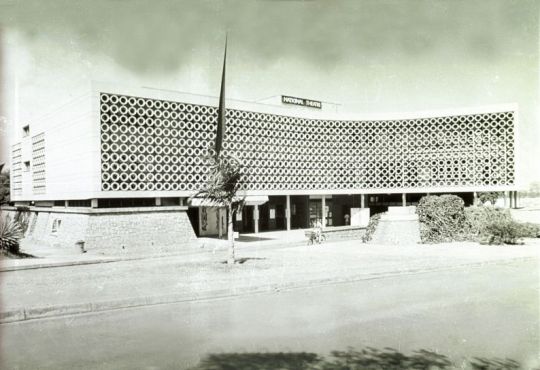
The main facade is an elegantly curved lattice of prefabricated concrete rings that act as a passive shading device. | Photo via Pinterst
Former telemetric control center of Transgas Complex is situated in the center of Prague. The complex is going to be demolished and rebuild.
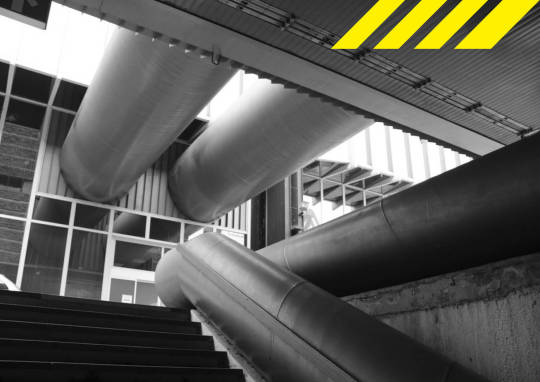
The overall architectural approach is an unusual mixture of High-tech details and New brutalism. | Photo © Petr Vorlík
The strong campaign against the demolition runs since 2015. After more than two years of negotiations on heritage protection, the Minister of Culture ended the case without resolving - facing the threat of proceeding for the lost profits from the owner, investor of the future administrative building. Docomomo International would like to express encouragement to the on-going efforts to protect the Transgas Complex from demolition.
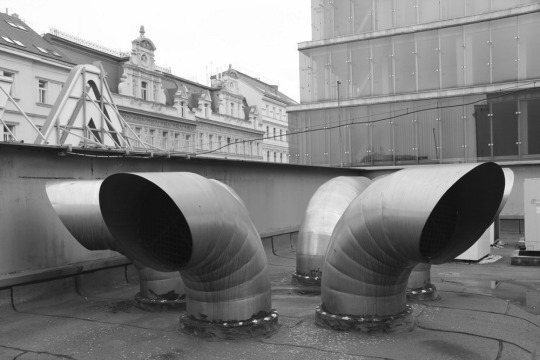
The pipes were used for the interior and exterior design. | Photo © Petr Vorlík
29 notes
·
View notes